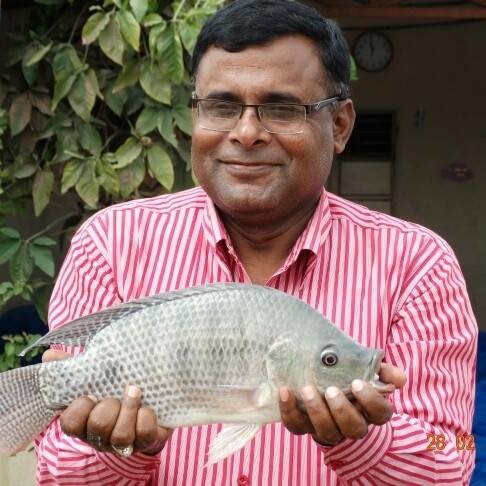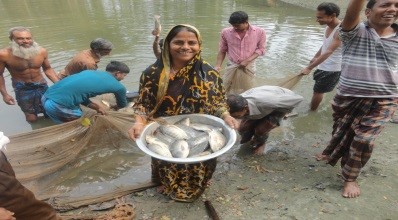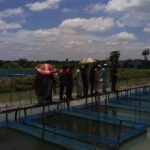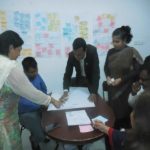
From green to silver: diversifying and intensifying production from rice to fish farming
Today, entering Trishal, Mymensingh on the road from Dhaka, one sees rows of fish ponds. One after the other, they show a massive diversification from rice to fish cultivation in recent years, and an intensification of production. The tradeoffs between green crops and silver fish appear to be clear, as ever more farmers see the benefits in terms of profits and returns, and make the move into fish farming.
“I was impressed with the innovative approach of CDAIS in bringing together fish farmers and organizations that support us, to find ways to overcome challenges we face in producing quality fish for local and overseas markets” explains Ritish Pandit of Ukilbari, Boilor, Trishal, after attending the capacity needs assessment workshop in February 2017. Mr Pandit started his fish farming and hatchery business in 1982, and thanks to his forward-thinking approach, supported by training and access to credit, he quickly expanded. In 2016-17, he sold almost 50 tonnes of fish, mostly tilapia and pangas (catfish), making a profit of 1.5 million Bangladesh Taka (US$18,500), including sales of fish fry and spawn. “And my business now employs four permanent staff and 16 temporary workers.” added Mr Pandit.
“The CDAIS approach of providing opportunities to participate, learn together and formulate joint solutions, and which will usher in new horizons for marginal fish farmers, in collaboration with stakeholders, and will surely help in successful implementation and achievement of the desired results.”Mr Ritish Pandit, fish farmer, Mymensingh
Great advances and glass ceilings
Bangladesh can be proud of its achievements in achieving self-sufficiency in food production. And now the fourth largest fish producing country in the world, this sector plays a key role though it only contributes 4% to national GDP. But in recent decades there have been major advances in fish culture from ponds and tanks, rather than from rivers and natural open water. This was made possible by new knowledge and technology transfer from international projects, conducive government policies, and support from the Department of Fisheries (DoF), the Bangladesh Fish Research Institute (BFRI), and the Bangladesh Agricultural University Faculty of Fisheries. And now, through new CDAIS participatory approaches.
In Trishal and Mymensingh, the potential of fish farming was shown in the 1990s with the introduction of tilapia and pangas that proved easy to raise, fetched a high price, and had high export demand. Mymensingh now supplies more than half of national pangas production, and one twelfth of all tilapias. But, this emerging sector is facing difficulties in fully realizing expected profits, due to the complex nature of fish value chains, poor availability of much-needed inputs, low quality feedstuffs, and challenges with market access.

“The main purpose of the new CDAIS system is to ensure that all stakeholders within a system have the opportunity to participate, learn together and to formulate joint solutions.”
CDAIS in Bangladesh
Work began in 2015 after a scoping study to identify the most innovative approaches, and fish farming was one of five ‘innovation niche partnerships’ selected. Each is supported by dynamic and specially trained ‘national innovation facilitators’ who deliver quality coaching and advisory services that target farmers and value chain stakeholders. The fish niche in Mymensingh district is supported by the CDAIS Country Project Manager, Agrinatura, and FAO Bangladesh. The niche focuses on tilapia and pangas due to their demand and export potential. Initial visits involved discussions with fish farmers and those working in and around the value chain, learning about existing issues, platforms and potentials. And following further discussions with government officials and other experts, key stakeholder groups were identified. Gender balance was emphasized, and the needs assessment workshop was organized with four main aims. These were to review the status of fish farming, problem analysis, strategic action planning, and policy recommendations to lead to win-win solutions for smallholder producers. The approach is based on the Tropical Agriculture Platform (TAP)’s five stage Common Framework on Capacity Development for Agricultural Innovation Systems, galvanizing commitment, visioning, assessing capacity needs, strategy development and implementation.
Assessing capacity needs
Over an intensive three days, 26 participants met in February 2017, organized around a series of innovative tools to stimulate thinking and help to comprehend the complex interactions within the network of actors in the fisheries niche in Mymensingh. These included timeline analysis, problem and solution trees, net mapping, combined visioning, and action planning. The aim? To identify a common vision for fish cultivation, capacity gaps, and innovative technical and functional capacity interventions. Half the participants were fish farmers or hatchery owners from one of three unions in Trishal, Boilor and Balipara,. Others included feed dealers and feed mill owners, aqua drug and equipment dealers, fish fry suppliers, input dealers, processors and retailers, and representatives of the government fisheries and marketing departments, the Bangladesh Fisheries Research Institute, Bangladesh Agricultural University, and NGOs.
Some Photos of CNA of Fish Cultivation Stakeholders at Trishal, Mymensingh
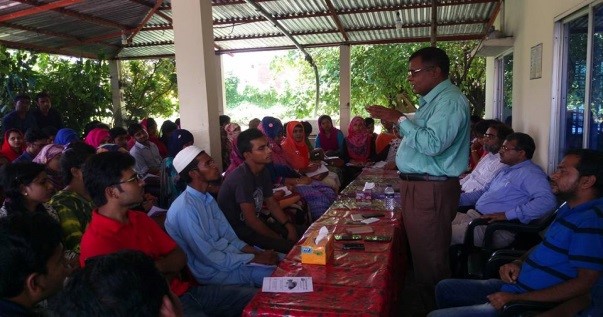
Unexpected benefits and positive outcomes
Participants discovered that the Department of Fisheries is developing a mobile phone ‘app’ to provide all kinds of information relevant to fish farmers. Also, during the workshop, arose the existence of a recently formed association working towards similar goals – the Tilapia Foundation –including 15 farmers, 8 hatchery owners, and the National Hatcheries Association which forms the basis for this as a fish innovation platform. The chairman, Dr Golum Hossain, former director general of the Fisheries Research Institute, told participants that he helped to establish this after a visit to a tilapia foundation in the Philippines, supported by the Katalyst project and the World Fish organization. And it looks forward to working with CDAIS, building functional capacities – soft skills such as the ability to collaborate, navigate difficulties, reflect and learn, and be a part of strategic processes.
The historical ‘timeline’ exercise showed that the development of fish farming in Mymensingh was due in part to there being many well educated young entrepreneurs who took up cultivation. And with government support, and help from universities and other farmers, this has facilitated growth, and increased consumer preferences for cheaper and tastier tilapia and pangas. Also, a lot of interest was shown in a new variety of Vietnamese pangas, and for the production of indigenous fish species that are on the verge of local extinction.
Remaining challenges, and overcoming them…
However, production is not rising fast enough to meet increased demand, because of high input costs for feed, fry, labour, loan interest, drugs, etc., lack of knowledge on modern fish culture technology, lack of marketing support, and few opportunities for making and building partnerships. Workshop participants prepared a ‘capacity development action plan’ to be adapted and implemented. Larger farmers are accustomed to working with each other and with government officials, researchers, universities and extension services, but they are not representative of marginal smallholder farmer groups. To make this crucial link, developing partnerships is key – facilitating local market links, and opportunities for processing for export.
But as was seen at the workshop , the concepts of ‘functional skills’ and ‘thinking in partnerships’ were not fully understood. Smallholder farmers are not used to working in partnerships, thinking that first, they must face up to more pressing challenges. But, experiences so far give the team confidence, and all participants saw that CDAIS facilitators and staff were involving them from the very beginning, and which had a positive effect. The workshop also helped to forge links that will help to directly respond to the most immediate issues, with contacts made with hatcheries, input stockists , producers, and and processing plants.
And the sharing of skills will go on. Mr Pandit offers regular but informal training to an ever-increasing number of other smallholder fish farmers in the hope that they can replicate his success. He is happy to share his experiences to help other farmers through the CDAIS project. And because demand is so huge, he has no fear of competition – rather, that additional production can only attract more buyers to the area.
Prepared by
Shila Fatema Wadud, national innovation facilitator, fish niche, Bangladesh shilawadedgp@gmail.com, 01711527865
The fish value chain is one of five innovation niche partnerships in Bangladesh, identified during the CDAIS scoping study. For more information, visit https://cdais.net/homee/pilots-countries/bangladesh/. The CDAIS project is implemented in Bangladesh by Agrinatura (represented by the Natural Resources Institute, University of Greenwich, UK), FAO Bangladesh, and the Bangladesh Agricultural Research Council, in partnership with other institutions, depending on which of the innovation agendas is under consideration.

